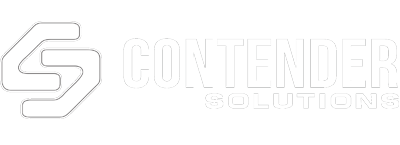Written By: Contender Solutions
There are a lot of IT-related acronyms floating around: ITSM, ITIL, ITX, ITOM, CMDB… the list goes on and on. Navigating the IT landscape requires having a strong understanding of what these IT services and practices all mean, how they relate to one another, and how they differ.
For example, ITSM and ITIL are two related IT terms that sometimes get confused. What’s the difference between ITIL and ITSM? What is ITSM and ITIL? And, how do ITIL and ITSM processes contribute to your business’ growth?
What Is ITSM?
ITSM is an acronym for information technology service management. To put it as simply as possible, in IT circles, ITSM is the term for all of the processes, procedures, activities, and policies that an organization uses for its IT services.
Alternatively, ServiceNow, a leading platform provider, defines ITSM as “the planning, delivery, and support of IT services via a mix of people, processes, and technology.”
Because of the rather large umbrella these definitions create, it’s easy to get ITSM confused with other IT acronyms and terms, as they may be part of an ITSM framework.
How ITSM Helps Your Business Grow
Every day, whether they realize it or not, businesses of all sizes and industries rely on ITSM to grow. The benefits of ITSM are not restricted to just tech companies!
For example, as noted in an article for FedTech, the National Cancer Institute (NCI) “works with ServiceNow to generate data out of every IT activity and then gain visibility into those activities across the enterprise for the IT team. The data is then used to cut down on the number of incident reports and improve efficiency.”
This helped NCI simplify their reporting and workflows so their team could work more efficiently and not waste as much time on redundant paperwork—without sacrificing visibility into the processes their reports were about.
The key benefits of ITSM include:
- Standardizing IT Practices. ITSM frameworks help organizations create a more consistent and reliable set of policies, procedures, and practices for their IT. This, in turn, helps to minimize confusion among staff so that the user experience (UX) for IT assets is better. It also helps avoid delays from misunderstandings about how the company’s IT solutions work and what each employee needs to do during a larger IT transformation.
- Improving Workflow Management. With a solid ITSM solution, companies can improve workflow management to streamline their business operations—helping to save more time and money while increasing efficiency.
- Defining Roles and Responsibilities. Who is responsible for what aspects of the company’s IT strategy? Comprehensive ITSM frameworks include policies for setting these roles and responsibilities to help improve IT service delivery and minimize the potential for confusion by creating accountability.
- Reducing Costs for IT Services. By streamlining workflows and optimizing the organization’s IT resources, policies, and procedures, ITSM can help companies reduce their costs for IT services.
- Improving User Experience. User experience is an enormous concern for all organizations—both for internal users (employees) and external users (customers). A positive UX helps improve adoption for business IT among employees so the company can realize the maximum benefits from its IT investments. Meanwhile, customers who have a positive user experience are more likely to engage with the company’s platform and products in the future (while bad UX drives them away).
These benefits go beyond simply supporting IT—they help the company’s IT department drive success and fuel growth for the entire organization. Finding ways to increase consistency and make processes more scalable is a crucial business strategy for any organization.
What Is ITIL?
ITIL is an acronym for information technology infrastructure library. This is a type of framework for ITSM that companies can use to organize their IT processes, policies, and procedures. So, ITIL and ITSM are closely related.
A popular definition of ITIL from CIO.com is “a library of volumes describing a framework of best practices for delivering IT services.” The framework covers distinct parts of the ITSM lifecycle for a business, including:
- Service Strategy;
- Service Design;
- Service Transition;
- Service Operation; and
- Continuous Service Improvement.
As noted by CIO, ITIL has undergone significant revisions since its first introduction, and the “newest version of ITIL focuses on company culture and integrating IT into the overall business structure.”
It’s also important to note that ITIL is a trademark of AXELOS.
The Benefits of ITIL
The benefits of ITIL can be numerous—especially considering the framework’s modern emphasis on aligning IT with an organization’s overall business strategy. Some potential benefits of using the ITIL framework include:
- More Effective Asset Utilization. By aligning IT assets with the organization’s business strategy, organizations can make more effective use of those assets within the business. Additionally, by identifying redundant or underutilized assets, organizations can eliminate these wastes of time and budget to streamline operations and make them more consistent across different business units.
- Improved Business Risk Management. Managing business risk is always a priority. By streamlining IT processes and eliminating wasteful redundancies, businesses can reduce the risk of service disruption and failure. They can also help improve their ability to assess risks for IT-related processes by streamlining them and reducing complexity.
- Increased Consistency and Repeatability for Business Processes. Having a set framework that is applied across the whole of the organization for IT helps improve consistency across every business unit. This, in turn, helps make important processes more repeatable since everyone approaches the same tasks in the same way.
The Differences Between ITSM and ITIL
When comparing ITSM vs. ITIL, it’s important to remember that it isn’t really a “versus” relationship. ITIL and ITSM are closely related since ITIL is a framework for delivering IT service management throughout an organization.
The key difference, then, is that ITSM is the high-level thing being delivered to the organization. Meanwhile, ITIL is how ITSM is delivered. To put it in terms that an automobile enthusiast might appreciate: If ITSM is the car that you ride in to get to your destination, ITIL is what makes up the frame, engine, wheels, drivetrain, etc. that makes the car move.
3 Other ITSM Frameworks
The ITIL framework is far from being the only one used to deliver ITSM. It just happens to be one of the frameworks for delivering service management for IT. Other ITSM framework examples include:
1. Control Objectives for Information and Related Technologies (COBIT)
According to Simplilearn.com, COBIT “was designed to be a supportive tool for managers—and allows bridging the crucial gap between technical issues, business risks, and control requirements.”
COBIT has a process-based model that divides models into four specific domains:
- Planning and organization;
- Delivery and support;
- Acquisition and implementation; and
- Monitoring and evaluating.
One potential weakness of the older COBIT methods noted in the Simplilearn.com article was that “COBIT practices can actually lead to a ‘Hot Potato’ situation wherein all stakeholders had passed on the tasks down the line.” Essentially, responsibility and ownership for tasks could be deferred by moving things along and causing limited accountability. The newest version of COBIT (5.0, released in 2012) seeks to address the potential weaknesses of previous iterations.
2. Business Process Framework (eTOM)
As noted by Lucidchart’s blog on the subject, the business process framework is “a hierarchical inventory of all the elements and systems involved in running an adaptable, agile, service-focused company.” Also known as eTOM, for “Enhanced Telecommunications Operations Map,” this framework concentrates on three main focuses found within most enterprises:
- Strategy, infrastructure, and product;
- Operations; and
- Enterprise management.
As the eTOM name suggests, this framework was originally developed for telecom companies. However, it eventually underwent a transformation to make it more broadly applicable to other enterprises. This helps explain why the eTOM framework includes items like supply chain development and other issues that aren’t always IT-specific.
3. Microsoft Operations Framework
The Microsoft Operations Framework (MOF) is a framework established by tech giant Microsoft designed to help IT professionals. The 4.0 version of MOF was published in 2008 and has remained in use for over a decade.
This ITSM framework is divided into four key phases, each of which has specific sub-tasks aligned to them:
- Plan. This phase includes service management functions to provide process guidance, such as aligning business operations with IT, managing finances, and setting policies.
- Deliver. This phase focuses on getting everything to the end user. Key tasks include project planning and then building, stabilizing, and deploying IT assets/solutions.
- Operate. This phase includes tasks like service monitoring and control, customer service, and problem management to ensure smooth operations.
- Manage. The overarching phase that sits atop the rest of the framework’s lifecycle. This is mostly concerned with managing governance, risk, compliance, changes in IT, and the IT team.
The MOF framework provides a clear method for evaluating key business challenges related to IT, such as service management costs, and methods for resolving those issues.
Each one of the frameworks outlined above have their own unique strengths and weaknesses that can make them ideal or ill-suited for a particular company and its business processes.
Do you need help establishing the ideal ITSM framework and solutions for your business? Reach out to the service management experts at Contender Solutions to get started!


